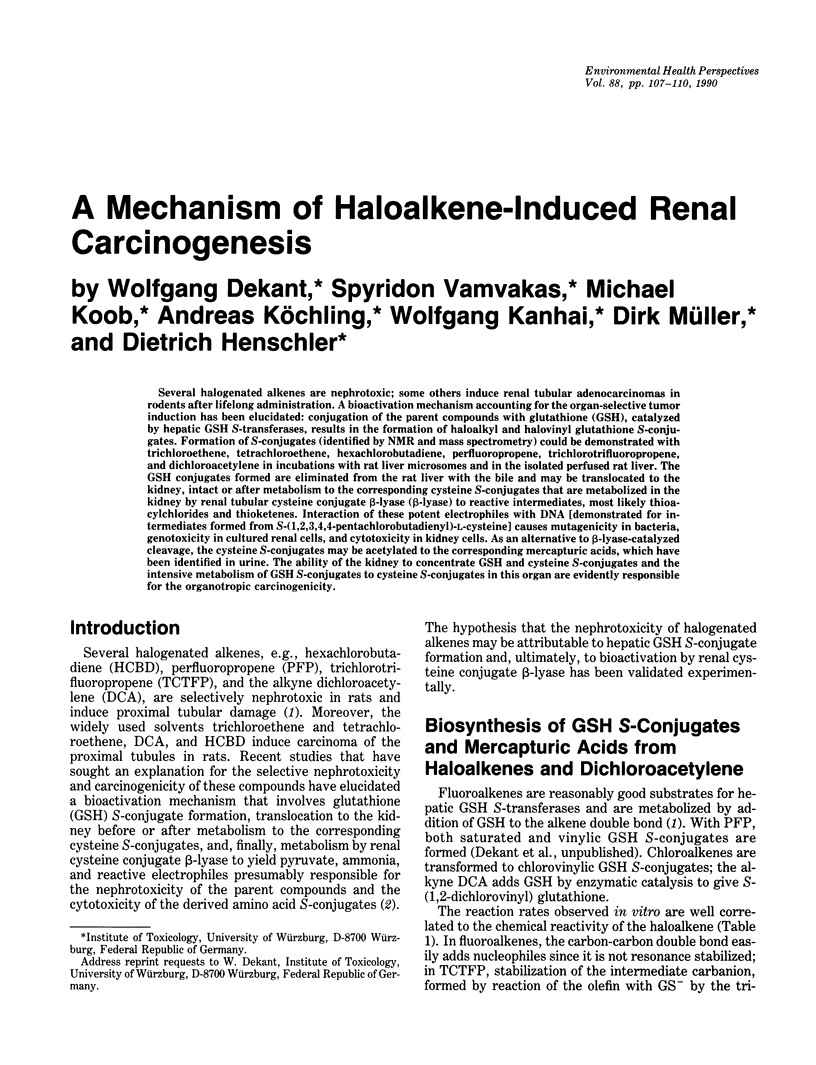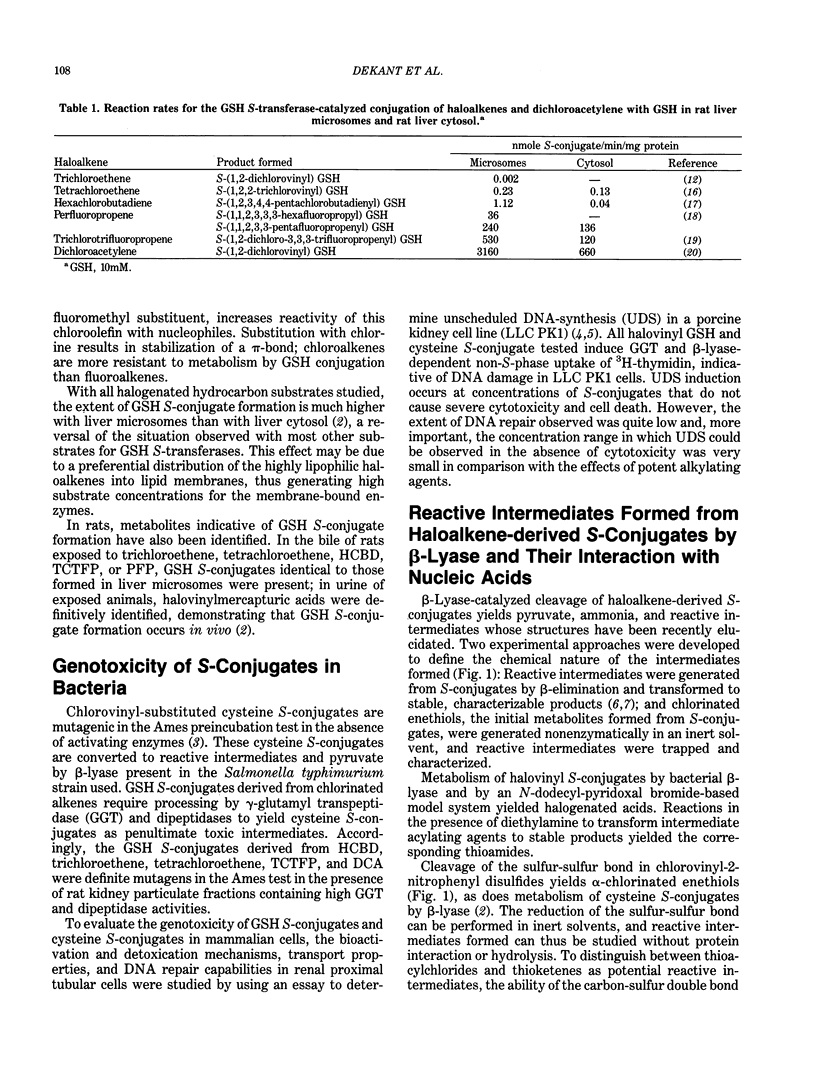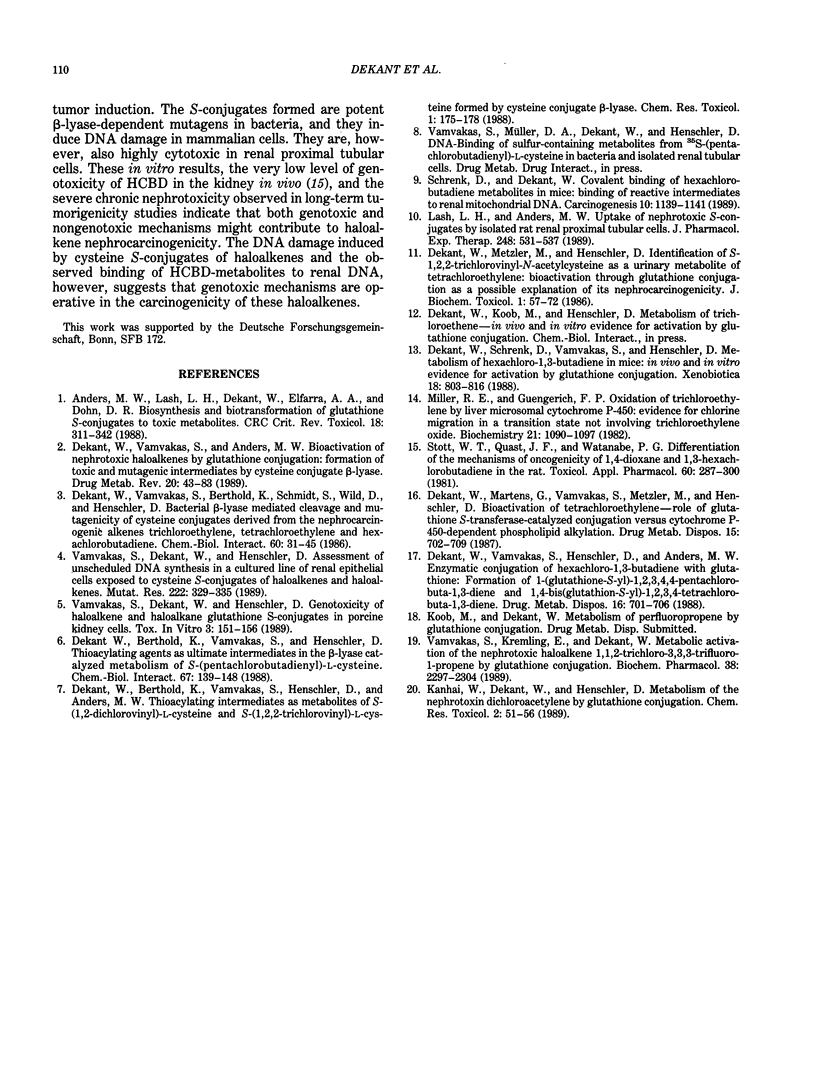Abstract
Several halogenated alkenes are nephrotoxic; some others induce renal tubular adenocarcinomas in rodents after lifelong administration. A bioactivation mechanism accounting for the organ-selective tumor induction has been elucidated: conjugation of the parent compounds with glutathione (GSH), catalyzed by hepatic GSH S-transferases, results in the formation of haloalkyl and halovinyl glutathione S-conjugates. Formation of S-conjugates (identified by NMR and mass spectrometry) could be demonstrated with trichloroethene, tetrachloroethene, hexachlorobutadiene, perfluoropropene, trichlorotrifluoropropene, and dichloroacetylene in incubations with rat liver microsomes and in the isolated perfused rat liver. The GSH conjugates formed are eliminated from the rat liver with the bile and may be translocated to the kidney, intact or after metabolism to the corresponding cysteine S-conjugates that are metabolized in the kidney by renal tubular cysteine conjugate beta-lyase (beta-lyase) to reactive intermediates, most likely thioacylchlorides and thioketenes. Interaction of these potent electrophiles with DNA [demonstrated for intermediates formed from S-(1,2,3,4,4-pentachlorobutadienyl)-L-cysteine] causes mutagenicity in bacteria, genotoxicity in cultured renal cells, and cytotoxicity in kidney cells. As an alternative to beta-lyase-catalyzed cleavage, the cysteine S-conjugates may be acetylated to the corresponding mercapturic acids, which have been identified in urine. The ability of the kidney to concentrate GSH and cysteine S-conjugates and the intensive metabolism of GSH S-conjugates to cysteine S-conjugates in this organ are evidently responsible for the organotropic carcinogenicity.
Full text
PDF



Selected References
These references are in PubMed. This may not be the complete list of references from this article.
- Anders M. W., Lash L., Dekant W., Elfarra A. A., Dohn D. R. Biosynthesis and biotransformation of glutathione S-conjugates to toxic metabolites. Crit Rev Toxicol. 1988;18(4):311–341. doi: 10.3109/10408448809037470. [DOI] [PubMed] [Google Scholar]
- Dekant W., Berthold K., Vamvakas S., Henschler D., Anders M. W. Thioacylating intermediates as metabolites of S-(1,2-dichlorovinyl)-L-cysteine and S-(1,2,2-trichlorovinyl)-L-cysteine formed by cysteine conjugate beta-lyase. Chem Res Toxicol. 1988 May-Jun;1(3):175–178. doi: 10.1021/tx00003a008. [DOI] [PubMed] [Google Scholar]
- Dekant W., Berthold K., Vamvakas S., Henschler D. Thioacylating agents as ultimate intermediates in the beta-lyase catalysed metabolism of S-(pentachloro-butadienyl)-L-cysteine. Chem Biol Interact. 1988;67(1-2):139–148. doi: 10.1016/0009-2797(88)90093-2. [DOI] [PubMed] [Google Scholar]
- Dekant W., Martens G., Vamvakas S., Metzler M., Henschler D. Bioactivation of tetrachloroethylene. Role of glutathione S-transferase-catalyzed conjugation versus cytochrome P-450-dependent phospholipid alkylation. Drug Metab Dispos. 1987 Sep-Oct;15(5):702–709. [PubMed] [Google Scholar]
- Dekant W., Metzler M., Henschler D. Identification of S-1,2,2-trichlorovinyl-N-acetylcysteine as a urinary metabolite of tetrachloroethylene: bioactivation through glutathione conjugation as a possible explanation of its nephrocarcinogenicity. J Biochem Toxicol. 1986 Jun;1(2):57–72. doi: 10.1002/jbt.2570010206. [DOI] [PubMed] [Google Scholar]
- Dekant W., Schrenk D., Vamvakas S., Henschler D. Metabolism of hexachloro-1,3-butadiene in mice: in vivo and in vitro evidence for activation by glutathione conjugation. Xenobiotica. 1988 Jul;18(7):803–816. doi: 10.3109/00498258809041719. [DOI] [PubMed] [Google Scholar]
- Dekant W., Vamvakas S., Anders M. W. Bioactivation of nephrotoxic haloalkenes by glutathione conjugation: formation of toxic and mutagenic intermediates by cysteine conjugate beta-lyase. Drug Metab Rev. 1989;20(1):43–83. doi: 10.3109/03602538908994144. [DOI] [PubMed] [Google Scholar]
- Dekant W., Vamvakas S., Berthold K., Schmidt S., Wild D., Henschler D. Bacterial beta-lyase mediated cleavage and mutagenicity of cysteine conjugates derived from the nephrocarcinogenic alkenes trichloroethylene, tetrachloroethylene and hexachlorobutadiene. Chem Biol Interact. 1986 Oct 15;60(1):31–45. doi: 10.1016/0009-2797(86)90015-3. [DOI] [PubMed] [Google Scholar]
- Dekant W., Vamvakas S., Henschler D., Anders M. W. Enzymatic conjugation of hexachloro-1,3-butadiene with glutathione. Formation of 1-(glutathion-S-yl)-1,2,3,4,4-pentachlorobuta-1,3-diene and 1,4-bis(glutathion-S-yl)-1,2,3,4-tetrachlorobuta-1,3-diene. Drug Metab Dispos. 1988 Sep-Oct;16(5):701–706. [PubMed] [Google Scholar]
- Kanhai W., Dekant W., Henschler D. Metabolism of the nephrotoxin dichloroacetylene by glutathione conjugation. Chem Res Toxicol. 1989 Jan-Feb;2(1):51–56. doi: 10.1021/tx00007a009. [DOI] [PubMed] [Google Scholar]
- Lash L. H., Anders M. W. Uptake of nephrotoxic S-conjugates by isolated rat renal proximal tubular cells. J Pharmacol Exp Ther. 1989 Feb;248(2):531–537. [PubMed] [Google Scholar]
- Miller R. E., Guengerich F. P. Oxidation of trichloroethylene by liver microsomal cytochrome P-450: evidence for chlorine migration in a transition state not involving trichloroethylene oxide. Biochemistry. 1982 Mar 2;21(5):1090–1097. doi: 10.1021/bi00534a041. [DOI] [PubMed] [Google Scholar]
- Stott W. T., Quast J. F., Watanabe P. G. Differentiation of the mechanisms of oncogenicity of 1,4-dioxane and 1,3-hexachlorobutadiene in the rat. Toxicol Appl Pharmacol. 1981 Sep 15;60(2):287–300. doi: 10.1016/0041-008x(91)90232-4. [DOI] [PubMed] [Google Scholar]
- Vamvakas S., Dekant W., Henschler D. Assessment of unscheduled DNA synthesis in a cultured line of renal epithelial cells exposed to cysteine S-conjugates of haloalkenes and haloalkanes. Mutat Res. 1989 Apr;222(4):329–335. doi: 10.1016/0165-1218(89)90108-0. [DOI] [PubMed] [Google Scholar]
- Vamvakas S., Kremling E., Dekant W. Metabolic activation of the nephrotoxic haloalkene 1,1,2-trichloro-3,3,3-trifluoro-1-propene by glutathione conjugation. Biochem Pharmacol. 1989 Jul 15;38(14):2297–2304. doi: 10.1016/0006-2952(89)90469-3. [DOI] [PubMed] [Google Scholar]


